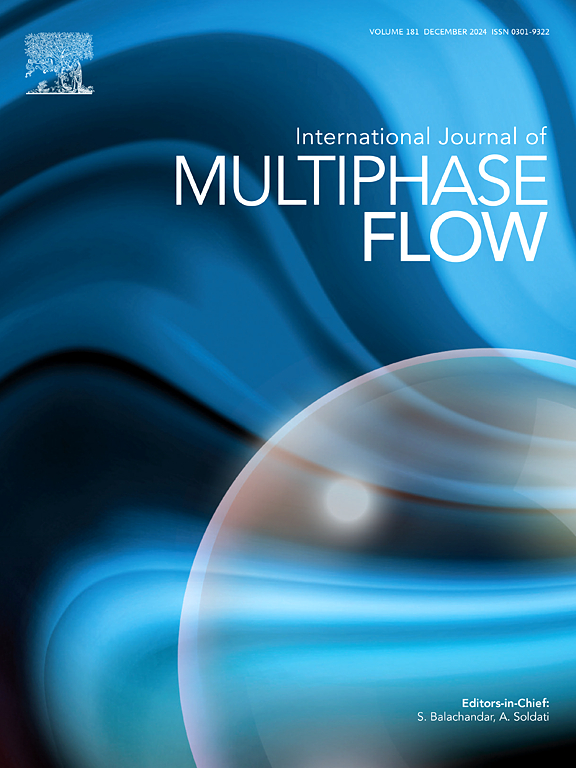Bubbles climbing on two vertical superhydrophobic sticks
IF 3.6
2区 工程技术
Q1 MECHANICS
International Journal of Multiphase Flow
Pub Date : 2025-01-12
DOI:10.1016/j.ijmultiphaseflow.2025.105133
引用次数: 0
Abstract
Bubble manipulation using superhydrophobic surfaces (SBS) is currently a subject of extensive research. Although flat surfaces have been the primary focus of investigation, with dimensions significantly larger than those of the bubbles, there has been limited attention given to the study of long slender SBSs, such as filaments and thin rods, which closely approximate the size of the bubbles. However, these elongated SBSs hold promise for enabling a wider range of bubble motion modes and an increased surface area for the bubbles. This study introduces the concept of double superhydrophobic sticks (DSBS) as a novel method to enhance the rising velocity (U) of buoyancy-driven bubbles. The examination identifies three distinct bubble configurations on the DSBS: nut-shaped, bell-shaped, and apple-shaped. Remarkably, the DSBS exhibits exceptional superaerophilicity, achieving a threefold increase in U for larger bubbles (with a diameter of approximately 4 mm). Prior research has already established the substantial impact of the length of the moving three-phase contact line (MCL) on the migration velocity of bubbles sliding on diverse planar SBSs. In contrast, our findings indicate that even the MCL length remains constant, the rising velocity of bubbles on DSBSs can be modulated by varying both the bubble size, the spacing between double sticks (S), and the diameter of the stick (Ds). Specifically, U is dependent on a revised Ohnesorge number (), following a log-linear-scaling relationship with U. Considering the altered impact of the S on the bubble shape, we propose the S as the characteristic length and the shape correction factor L* () for the revised Ohnesorge number. Here, deq is the equivalent diameter of the bubble, ε* is the normalized stick gap ratio. The scaling law identified in this investigation effectively enables the simultaneous prediction of both the morphology and rising velocity of bubbles on the double sticks. Hence, our bubble manipulation method and its associated predictive model exhibits promising prospects for implementation across a range of gas-liquid systems, encompassing improved electrolytic hydrogen production, gas-liquid separation, adjustable flotation, and advanced surface chemistry.

求助全文
约1分钟内获得全文
求助全文
来源期刊
CiteScore
7.30
自引率
10.50%
发文量
244
审稿时长
4 months
期刊介绍:
The International Journal of Multiphase Flow publishes analytical, numerical and experimental articles of lasting interest. The scope of the journal includes all aspects of mass, momentum and energy exchange phenomena among different phases such as occur in disperse flows, gas–liquid and liquid–liquid flows, flows in porous media, boiling, granular flows and others.
The journal publishes full papers, brief communications and conference announcements.

 求助内容:
求助内容: 应助结果提醒方式:
应助结果提醒方式:


